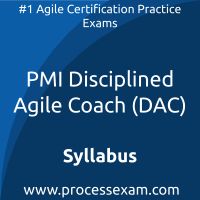 To achieve the professional designation of PMI Disciplined Agile Coach from the PMI, candidates must clear the DAC Exam with the minimum cut-off score. For those who wish to pass the PMI Disciplined Agile Coach certification exam with good percentage, please take a look at the following reference document detailing what should be included in PMI Disciplined Agile Coach Exam preparation.
To achieve the professional designation of PMI Disciplined Agile Coach from the PMI, candidates must clear the DAC Exam with the minimum cut-off score. For those who wish to pass the PMI Disciplined Agile Coach certification exam with good percentage, please take a look at the following reference document detailing what should be included in PMI Disciplined Agile Coach Exam preparation.
The PMI DAC Exam Summary, PMBOK Guide, Sample Question Bank and Practice Exam provide the basis for the real PMI Disciplined Agile Coach (DAC) exam. We have designed these resources to help you get ready to take PMI Disciplined Agile Coach (DAC) exam. If you have made the decision to become a certified professional, we suggest you take authorized training and prepare with our online premium PMI Disciplined Agile Coach Practice Exam to achieve the best result.
PMI DAC Exam Summary:
| Exam Name | PMI Disciplined Agile Coach |
| Exam Code | DAC |
| Exam Fee Member | USD $270.00 |
| Exam Fee Non-Member | USD $340.00 |
| Exam Duration | 120 Minutes |
| Number of Questions | 60 |
| Passing Score | PASS or FAIL |
| Format | Multiple Choice Questions |
| Schedule Exam | Pearson VUE |
| Sample Questions | PMI Disciplined Agile Coach Exam Sample Questions and Answers |
| Practice Exam | PMI Disciplined Agile Coach (DAC) Practice Test |
PMI Disciplined Agile Coach Syllabus Topics:
| Topic | Details | Weights |
|---|---|---|
| The Disciplined Agile Coach |
- Define and Describe the DA Coach and how it fits into the certification journey - Explain why DA coaching is important and how it is more effective than “regular” agile coaching - Explain how the DA Toolkit supports coaching - Describe the different process goals |
8.3% |
| Facilitate the DA way |
- Demonstrate how to plan and facilitate training, events, and ceremonies - Identify, plan, and refine the flow and techniques the DA way - Develop ground-rules and facilitate collaboration |
6.7% |
| Engage the Stakeholders |
- Identify when and how to involve all stakeholders - Analyze the purpose and context for the transition to DA - Identify training needs and DA gaps - Develop a coaching agreement and build confidence - Define metrics and other approaches for a successful transition - Develop the roadmap and identify sponsors for the transition - Construct and document brainstorming sessions across the enterprise - Explain, market, and promote the new vision to stakeholders - Explain core concepts and change management to stakeholders |
15% |
| Communicate Continuously |
- Analyze information in gap analysis - Construct and verify objectives that support the vision - Identify and sequence the initial initiatives - Explain impacts to stakeholders throughout the process - Demonstrate support for the organization in communicating and making the change process visible - Identify the key components of a successful community of practice |
10% |
| Mentorship and Leadership |
- Develop mentorships at individual levels up and down stream - Demonstrate different methods to seek DA solutions - Apply team building skills and knowledge - Utilize and apply emotional intelligence skills and principles (i.e. empathy, etc.) - Model the continuous improvement of communication skills - Apply psychological safety and the creation of an open and safe environment - Apply negotiation, problem solving, and decision-making skills - Demonstrate active listening - Model and encourage collaboration |
16.7% |
| Guided Transition and Continuous Improvement |
- Apply various methods, practices, and techniques to a situation - Construct, introduce, facilitate, and review actions/experiments to the organization using systems thinking - Identify initiatives for visible continuous improvement - Define success criteria, set, and manage expectations - Identify short term wins to determine early successes - Identify training needs - Facilitate organizational re-design and develop formal paths for change |
11.7% |
| Coaching, Consulting, Counseling, and Lean Leadership |
- Identify issues and explore ’why’ with the working group - Demonstrate an understanding of personal emotional regulation and presence - Demonstrate listening, questioning, flexibility, and continuously adapt to situations - Plan goals with individuals, teams, and the organization - Develop, integrate, and tailor frameworks and toolkits - Explain to the client areas of improvement and benefits of solutions - Define the appropriate measurement and tracking systems - Identify ways to create and cultivate a psychologically safe environment - Explain how to nurture the motivation people - Explain the practice of mission command - Model methods for a middle-up-down management approach |
18.3% |
| Training and Development |
- Develop an environment for continuous learning - Develop formal learning outcomes - Utilize different content delivery mechanisms - Identify and socialize sources of information |
6.7% |
| Thought Leadership |
- Relate how the DA Toolkit relates to other practices - Take part in Communities of Practice - Identify ways that challenge the DA program to always improve - Apply DA Value for the benefit of the community |
6.7% |
Both PMI and veterans who’ve earned multiple certifications maintain that the best preparation for a PMI DAC professional certification exam is practical experience, hands-on training and practice exam. This is the most effective way to gain in-depth understanding of PMI Disciplined Agile Coach concepts. When you understand techniques, it helps you retain PMI Disciplined Agile Coach knowledge and recall that when needed.
